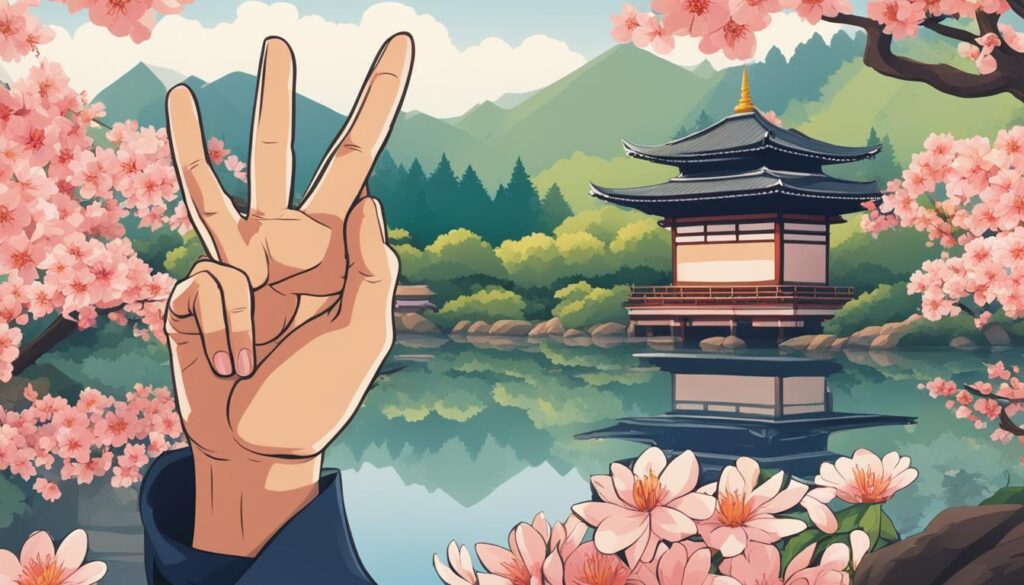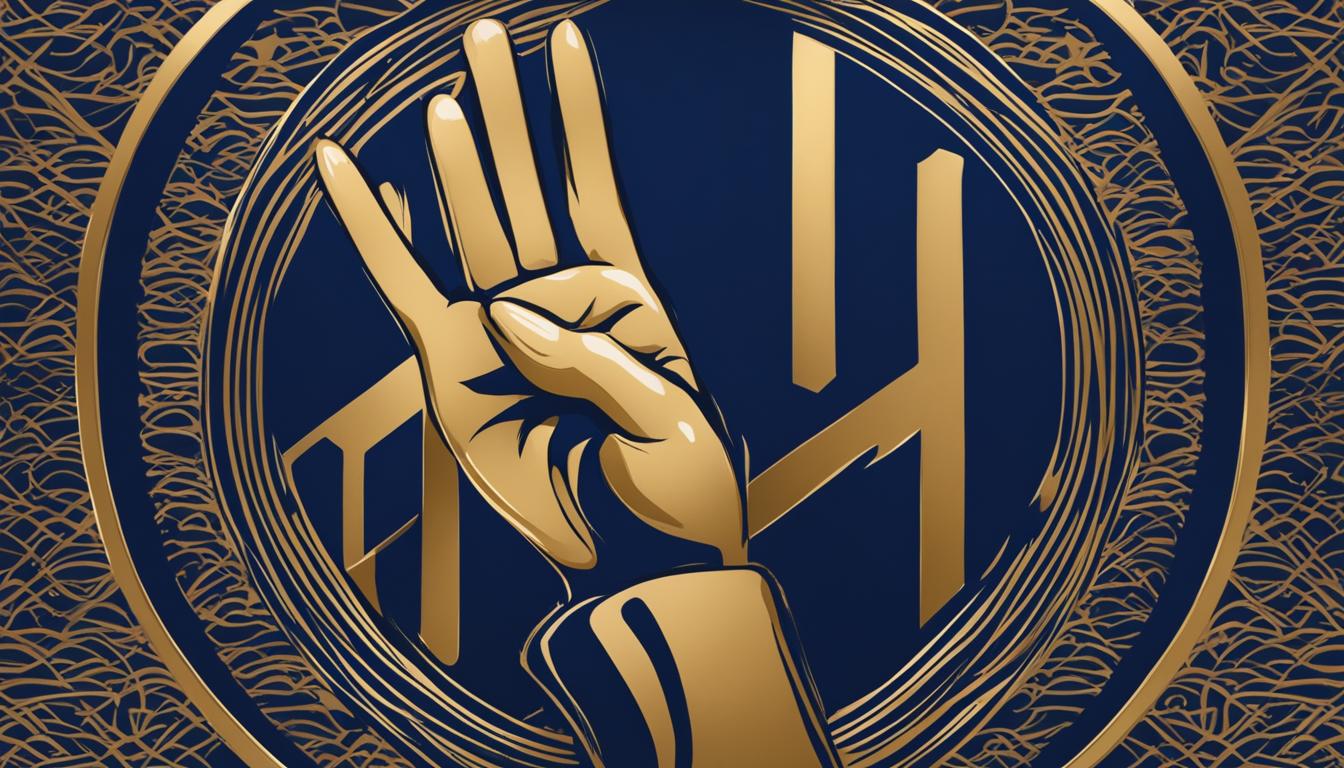Are you curious about how to say “peace sign” in Japanese? The peace sign is a universally recognized gesture that originated in Japan and has gained popularity worldwide. In this article, we will explore the meaning and grammar behind this iconic symbol, learn how to pronounce it, find equivalent words, and delve into the contextual and cultural usage of the peace sign in Japan.
Let’s dive in and discover the fascinating world of the peace sign in Japanese culture!
The History of The “V”: The Peace Sign and Its Tales of Origin
The peace sign, also known as the V sign, has multiple origin stories, making it difficult to pinpoint its true history. The V sign was not widely used before the 20th century. One origin story suggests it originated as an insult in England, with the palm facing inward. During World War II, the V sign represented victory and was popularized through campaigns in various countries. It was later adopted by anti-war movements, including protests against the Vietnam War. The peace sign is now associated with peace and positivity in Japan, and it is commonly used in photographs to show gracefulness and cuteness.
| Origin | Meaning |
|---|---|
| Insult in England | Originated as a derogatory gesture with the palm facing inward. |
| World War II | Represented victory and was promoted through campaigns. |
| Anti-war movements | Adopted by protests against the Vietnam War. |
| Japanese culture | Associated with peace and positivity, commonly used in photography. |
Cultural Snapshots: The Peace Sign in Japanese Photography

The peace sign has become a cultural phenomenon in Japanese photography. It is commonly used as a pose in photographs, particularly when having a photo taken. The use of the peace sign close to the face is popular among young people, especially women, as it can partially cover the face or make it appear slimmer. This gesture has become a part of the kawaii (cute) culture in Japan and has gained popularity in the anime subculture and mainstream internet culture. The peace sign is also convenient for posing in photographs, as it gives people something to do with their hands and has a positive and peaceful symbolism.
Joining in On the Fun: Tips for Foreigners Embracing The Gesture
If you’re visiting or living in Japan, you may find yourself wanting to join in on the popular peace sign gesture in photographs. Embracing this gesture requires an understanding of its cultural significance and meaning. In Japanese culture, the peace sign represents peace and positivity.
When posing for a photograph in Japan, it is common to hear the phrase “Peace!” instead of the typical “Say cheese!” To make the peace sign, it is important to place your palm outward, with the index and middle fingers forming a V shape. This gesture is considered a friendly and welcoming pose in Japanese culture, and understanding its meaning can help foreigners fully participate in this cultural practice.
By embracing the peace symbol translation to Japanese, you can connect with the local culture and show respect for customs. Remember to keep your palm facing outward and ensure your index and middle fingers form a clear V shape. This gesture may not only enhance your photographs but also allow you to fully experience the positivity and gracefulness associated with the peace sign in Japanese photography culture.
Frequently Asked Questions About the Asian Peace Symbol: The “Peace” Hand Sign
The peace sign, also known as the V sign, is a popular hand gesture in Japan that often raises questions among foreigners. Here are some frequently asked questions about the peace hand sign and its cultural significance in Japanese society:
What is the meaning of the peace sign in Japanese culture?
The peace sign holds a symbolic meaning of peace and positivity in Japanese culture. It is commonly associated with the ideals of harmony, tranquility, and non-violence.
What is the origin of the peace sign in Japan?
The exact origin of the peace sign is uncertain and has various origin stories. It gained popularity during World War II as a symbol of victory and later became adopted by anti-war movements, including protests against the Vietnam War. The peace sign eventually found its way into Japanese culture through various events and media.
How is the peace sign used in Japanese photography?
In Japanese photography culture, the peace sign is commonly used as a pose in photographs, particularly among young people. It has become a part of the kawaii (cute) culture and is often used to partially cover the face or make it appear slimmer. The peace sign poses add a sense of gracefulness and positivity to the photographs.
Is there a specific way to make the peace sign in Japan?
Yes, there is a specific way to make the peace sign in Japan. To create the peace symbol, you simply raise your hand, extend the index and middle fingers, and keep your palm facing outward. The V shape formed by the index and middle fingers represents peace and signifies the peaceful intentions behind the gesture.
Understanding the history and cultural significance of the peace sign can provide valuable insights into its usage in Japanese society and help foster a deeper appreciation for this symbolic gesture.
Conclusion
The peace sign, a widely recognized symbol in Japanese culture, has gained popularity worldwide. Its history is complex and has various origin stories, but it is commonly associated with peace and positivity. In Japanese photography culture, the peace sign is a common pose, particularly among young people, and has become a part of the kawaii culture. It is often used to partially cover the face or create a slimmer appearance.
Understanding the cultural significance of the peace sign can help foreigners appreciate and participate in this aspect of Japanese culture. When visiting or living in Japan, embracing the peace sign gesture in photographs is a way to connect with the local customs and show respect for the culture. By placing the palm outward and forming the V shape with the index and middle fingers, you can create a friendly and welcoming pose that aligns with the symbol’s meaning of peace.
Whether you are a tourist or a long-term resident, the peace sign can serve as a bridge to understanding and embracing Japanese traditions. The peace sign hand gesture and its symbolic meaning in Japanese society reflect a desire for harmony and goodwill. So, next time you take a photo in Japan or encounter someone making the peace sign, you can now appreciate the deeper cultural significance behind this iconic gesture.

